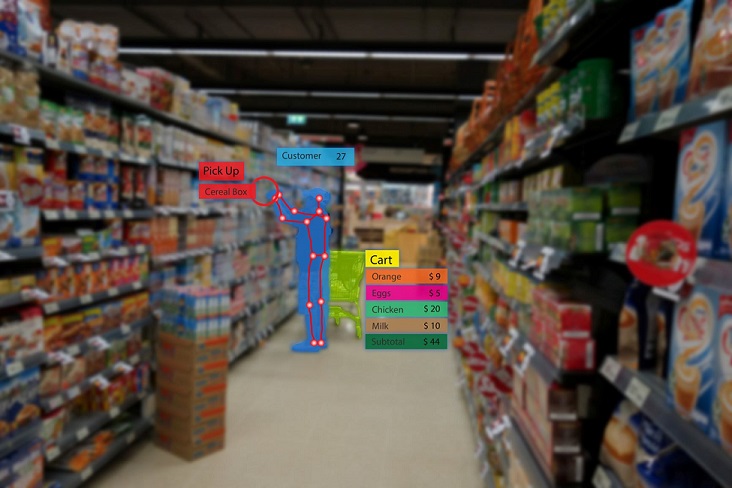While 2018 was the best holiday shopping season in six years (US sales were up more than 5 percent in stores), closures of big names such as Sears and ToyRUs demonstrate the fragile state of brick-and-mortar stores. And, during that same season, online sales saw a much larger increase: up 19 percent from the year before.
But all hope is not lost for traditional stores, with smart retail giving new hope to physical stores looking to compete with e-commerce giants such as Amazon. Investments in smart retail solutions such as smart shelves and carts use IoT connectivity to transform the in-store shopping experience and improve operational efficiencies.
As more stores implement IoT and smart retail devices, the return on investment is clear—smart retail earns an A+ for ROI.
Smart retail technology: Powered by IoT
Smart retail innovations are powered (and connected) by IoT. IoT sensors, cameras, and other devices record data that is analyzed in real time (or near real time) to identify trends, predict issues before they occur, and increase customer engagement.
There has been a steady evolution in the types of sensors over the years. Sensors are used to monitor weight, vibrations, temperature, and other factors. RFID sensors are playing a particularly big role when it comes to retail.
Electronic tags with RFID chips allow stores to track inventory. Retailers can track which items are moved within stores (and where they are moved). RFID tags also allow retailers to track items throughout the entire supply chain, from the warehouse to the shelf in your store.
IoT connects RFID tags, sensors, and other IoT devices to the internet, so data can be recorded, transmitted, and analyzed. These devices are breathing new life into physical stores, giving them a chance to survive in an increasingly virtual world.
Smart devices add new life to brick-and-mortar stores
Smart shelves
Smart shelves use IoT sensors built into the shelves to measure and monitor products that are handled, removed, or moved. These wireless systems use various types of IoT sensors or RFID tags and readers to monitor products.
Store owners can track inventory in real time, immediately restocking an item once it falls below a set threshold. Misplaced items also trigger an alert, so they can be put back in the correct place right away.
Smart shelf data allows retailers to plan better for the future, ordering more of the hot items and fewer of the less popular ones. A smart shelf can also assist customers, suggesting related items if something is out of stock or if there is an upsell opportunity. The T-shelf is an example of a smart shelf that uses a sensor based on printed electronic ink to deliver on-the-shelf availability data.
Some retailers are combining smart shelves with digital signage to further increase customer engagement. Digital signs update prices in real time, provide additional product details, and display relevant sales information.
Kroger is leading the way for supermarket retailers in implementing smart shelf technology across stores.
iBeacons
This smart technology device can be installed anywhere in a retail store to send information to customers. When a customer comes close to an iBeacon, the device sends out tiny radio signals to the customer’s smartphone.
Notifications can be sent to the smartphone about products or promotions to enhance the shopper’s in-store experience. If, for example, an iBeacon is placed under the most popular television you’re selling, and a customer stops in front of it to check it out, the shopper’s smartphone can instantly receive detailed product information.
These IoT devices deliver pertinent information to a shopper when they are physically in your store looking at a specific product—right at the purchase decision point.
Mobile POS
While self-checkout is quite common these days, innovations are making this experience smarter, faster, and more secure. Support for such payment options as Apple Pay allows customers to seamlessly and securely check out items with smartphones.
RFID-based checkout systems allow customers to check out in one fell swoop, with all items being placed in one bag or cart while the RFID tags on each item are read simultaneously.
The Apple Store itself has taken this a step further, arming customers with the ability to check themselves out from an app. This makes it that much easier for customers to buy and eliminates the frustration and cart abandonment that long lines create.
Amazon has also taken a futuristic approach with its stores, using cameras and visual processing to observe people shop and record the products they carry out.
Smart retail mobile apps
While many stores have moved into the mobile app space, retail apps are becoming smarter by creating a more interactive customer experience inside stores.
For example, a customer can use a retail mobile app to scan a product code, then see additional information about that product. This keeps the customer engaged, eases the shopping experience, and makes them more likely to buy (and return to your store for future purchases). And if your app doesn’t let shoppers do this, the Amazon app does. Users can scan barcodes in your store to see how much that item costs on Amazon.
Retailers such as Kenneth Cole and Timberland are at the forefront of the smart retail app category, with customers receiving personalized greetings and notifications as soon as they walk inside. It’s important to note that retailers need to find a way to make sure customers are running the app when they shop. You need to create enticements to get shoppers to open and use the app so these interactions can occur.
Smart carts
Cameras, IoT weight sensors, a barcode scanner, and a small screen turn a shopping cart into a smart cart that can actually check out a customer while they shop.
Smart carts are at the beginning of their development, but we do expect innovation to continue. We won’t be surprised when we see smart carts popping up in more retail stores over the coming years.
The benefits: Smart retailing increases ROI
Connect the physical and digital worlds
The modern customer often shops for products online and offline. IoT unites these two worlds, so retailers can provide a seamless customer experience across channels.
Customers can “buy online and pickup in store” (BOPUS) and receive information online while inside your store. It is the perfect union that allows customers to make informed decisions and increase overall sales.
BOPUS is one way to make sure your app is running when customers enter the store because the app will tell them when and how to pick the item up. This gives you, as a retailer, a chance to push more information to the shopper.
Optimize the visual and sensory in-store experience
The major benefit physical stores have over the online world is the ability for customers to see and feel products in person. IoT and smart retail enhance the visual and sensory experience through personalized greetings, custom-tailored coupons and promotions, and relevant in-store product suggestions.
Manage inventory in real time
It is not enough for a retailer to know if inventory is low on an item, especially those that are displayed in more than one place in your store. You need to know which display is running low so you can immediately restock it.
The combination of RFID tags, IoT sensors, and cameras allow retailers to monitor and track inventory at specific locations throughout the store.
Reduce theft
Video cameras have been in retail aisles for decades, warning customers they are being watched. IoT adds a new layer of theft protection through data analysis and algorithms that notify security when potential theft is happening.
For example, it may be common for a customer to purchase one, or maybe two, razor blades. Removing twenty from the shelf, however, will trigger an alert.
Retailers can rely on IoT and open up locked cases on these high-theft items, making them more accessible to shoppers without having to worry about theft.
Improve customer engagement and store layout
Discover whether your displays are effective. Find out if customers are stopping and spending time there or just walking by.
Are customers picking up a product? Are they putting it in their cart or putting it back on the shelf?
Data analytics provides answers to these questions so retailers can improve design displays and optimize store layout.
Achieve better planogram compliance
Retailers need to know products are on the right shelf with the right price displayed. Smart shelves such as the T-shelf identify planogram compliance issues immediately, so they can be resolved in real time.
Better yet, retailers can load shelf layout into a database associated with the T-shelf and a planogram is automatically generated, saving time and effort while increasing compliance.
Optimize the supply chain
Track the temperature of goods during shipping and how long they have been in transit. If a product requires a certain temperature during transit, an alert can notify personnel before a real emergency arises.
Identify inefficiencies in the supply chain so they can be corrected. With RFID, inventory items can be scanned simultaneously rather than one at a time, saving time in the inventory and shipping process.
Smart retail technology gives brick-and-mortar stores the opportunity to compete with the e-commerce giants that seem to be taking over. In fact, one might argue smart retail devices give physical stores a leg up on online shopping, by marrying the physical and digital worlds together and giving customers the ultimate shopping experience. Be sure to seek out professional advice if you’re not quite sure of the best way to test out the smart retail waters, so you can maximize your ROI and get results quickly.

